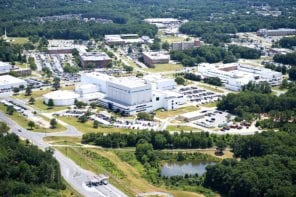
Michael Griffin
By Michael Banks
When Physics World talked to NASA boss Michael Griffin in July – on the occasion of NASA’s 50th birthday — he noted that the agency hoped to have manned missions to the Moon by 2020 and Mars by 2050. Griffin reiterated that view in a session yesterday at the International Astronautical Congress in Glasgow with heads of agency and industry space leaders. However, he also warned about putting too much priority on a potential Mars mission. “We have had only 27 Earth days on the Moon,” said Griffin, referring to the previous six Apollo manned lunar missions. “But our dependents will think we are idiots; that we don’t know enough about the Moon, if we don’t revisit it.”
For anyone who thinks a mission to Mars would be the space equivalent of a walk in the park, Griffin put the potential mission in context. “Mars is an interesting place for human beings,” he said, “but we have to show that astronauts can survive the mission time by first putting them for seven months on the International Space Station (ISS) then 9-12 months on the moon followed by another 7 months on the ISS.”
Russia’s deputy head of ROSCOSMOS, Alexander Medvedchikov, said that it seems reasonable to test new technology to go to the Moon and then using it to venture to Mars, rather than relying on technology that is decades old. But he also said that “we must know the objectives first, whether they are for developing long-standing technology or if they are purely political goals.”
Meanwhile, Alexander Derekin, deputy chief designer of Korolev Rocket and Space Corporation Energi, warned that we should not just “repeat the Apollo programme”, but instead develop the new technologies that will both go to the moon and mars.
A subsequent session on Moon exploration featured lots of slides showing astronauts on futuristic lunar colonies. One presenter even went as far a showing half a dozen or so modules of a colony, all connected like some kind of fancy hamster house. All of which seems rather unreal given the economic troubles back here on Earth. But according to Bill Larson of the Kennedy Space Center, oxygen will be the “currency” for a future lunar economy.
In a talk, he outlined some projects being developed to “harvest” the moon’s soil to produce oxygen. The soil — or regolith — is about 10 cm deep and has a relative concentration of around 45% of oxygen with other elements such as silicon (22%), iron (14%) and calcium (8%) making up the rest.
Scientists, Larson explained, are researching how to best extract the oxygen with techniques such as molten electrolysis, which would involve heating up the soil to high temperatures. They calculate that it would only take the size of a soccer field to excavate 10 million metric tonnes of oxygen every year. Rovers are currently being tested and the plan is to have a proof-of-concept study ready by the end of 2014, just in time for the first Moon outpost on 2023.



